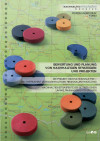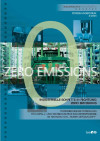Suchergebnisse
Berichte aus Energie- und Umweltforschung 30/2002 Die Projekt-Innovations-Matrix

Ein Instrument zur nachhaltigen Regionalentwicklung. Teil 2. Weiterentwicklung und Fallstudien
Berichte aus Energie- und Umweltforschung 6b/1996 Dokumentation: Ökopartnerschaft der Gemeinde mit den Betrieben Wolfurt - Kurzfassung

Die Entwicklung der Ökologiegeschichte Wolfurts bis hin zum Projekt Öko-Partnerschaft
Berichte aus Energie- und Umweltforschung 21/2002 Textile Fasermodifikation: umweltschonenden Verarbeitungsprozesses von Viskosefasern

Basierend auf den Ergebnissen dieser Untersuchung ist zu erwarten, dass mit einer neuen Fasergeneration, eine Reduktion des Einsatzes von Energie, Wasser und Chemikalien zwischen 40 und 100% zu erreichen ist.
Berichte aus Energie- und Umweltforschung 20/2002 Nachhaltig Gründen: Anregungen für Gründerinnen und Gründer Nachhaltiger Unternehmen

Die Broschüre ist ein direktes Ergebnis aus der wissenschaftlich-fachlichen Begleitung und Unterstützung der Gründungsinitiative "Nachhaltig Wirtschaften".
Bewertung Und Planung Von Nachhaltigen Strategien Und Projekten

Die Projekt-Innovations-Matrix - Ein Instrument zur nachhaltigen Regionalentwicklung Nachhaltigkeitsaspekte bei betrieblichen Umweltmanagementsystemen
Forschungsforum
1/2003
Herausgeber: BMVIT
Deutsch, 6 Seiten
Downloads zur Publikation
Berichte aus Energie- und Umweltforschung 7/1998 Grundlagen für die Ausrichtung eines Technologieschwerpunktes "Nachhaltig Wirtschaften"

Machbarkeitsanalyse
Urban Future - Erhebung von Forschungsfragen zum Thema "Resource Efficient City of Tomorrow"
Herausforderungen für die Städte der Zukunft mit relevanten Forschungsfragen im Hinblick auf Ressourcenmanagement, Ressourceneffizienz und Technologieentwicklungen
RISKMIN - Risk minimization along the value-added chain of plants to the colouring pigments
RISKMIN is a project for the mitigation of risks along the supply chain of plant raw material to the provision of plant dyestuff. Considering the measures concerning risk mitigation, a business plan for a plant dyestuff manufacturer for the effective realization of the business idea was created.
Pflanzenkläranlagen für die Kreislaufschließung und Reinigung industrieller Prozesswässer
Maßnahmen zur Reduktion von Wasserverbrauch und Abwasser in Industrie und Gewerbe, Technologien zur selektiven Entfernung von Wert- und Abfallstoffen aus dem Abwasser, Fallstudien in Unternehmen kleiner und mittlerer Größe der Lebensmittelbranche
EOR - EASEY Online Rating - a roadmap of a free of charge online service for small businesses
Preparation tool for the bank rating; model and indicators - concept for communication and technological options.
INERIWI: Integrierte Nutzungsmodelle zum effizienteren Rohstoffeinsatz im Wirtschaftsbereich
Für wesentliche ressourcenintensive Bedarfsfelder im Wirtschaftsbereich wird die eigentliche Funktion der Produkte analysiert und ausgearbeitet, welche Möglichkeiten bestehen, die eigentliche Dienstleistung bzw. die Funktionen eines Produkts ohne dessen Verkauf bereitzustellen. An Hand der Material- und Energieintensität dieser Bedarfsfelder werden das Potenzial der Umweltentlastung durch integrierte Nutzungsmodelle sowie die ökonomischen und sozialen Implikationen für einzelne Wirtschaftsbereiche abgeschätzt.
Pilotanlage zur Herstellung von extraleichten Sandwichteilen aus Kunststoff im Batchbetrieb
Weiterentwicklung einer Prototypenanlage zur Herstellung von neuartigen Monowerkstoff-Sandwichelementen aus Polypropylen als Karosseriebestandteile für Elektrofahrzeuge und andere Anwendungen im Leichtbau. Aufbauend auf den Ergebnissen eines Bridge-Projektes wurde eine Pilotanlage entwickelt und gebaut, welche einerseits die Herstellung von Nullserien erlaubt und andererseits die notwendigen Erkenntnisse für eine geplante Serienproduktion liefert.
Berichte aus Energie- und Umweltforschung 5/2001Produktion von farbstoffliefernden Pflanzen in Österreich und ihre Nutzung in der Textilindustrie

Verknüpfung des landwirtschaftlichen Angebotes an Rohstoffen mit den Erfordernissen der verarbeitenden Gewerbe- und Industriebetriebe
Mehrsprachig
Eignung und Anwendbarkeit von Bewertungsmethoden für nachhaltiges Wirtschaften

Vorrangiges Ziel der Studie ist die Erleichterung der zielgerichteten Auswahl von bzw. des Umgangs mit Bewertungsmethoden im Bereich Nachhaltige Entwicklung. Im Mittelpunkt steht dabei die Erstellung einer virtuellen "Landkarte" von Bewertungsmethoden, die die Anforderungen der Bewertungsfragestellung auf die Methodeneigenschaften abbildet. Daraus resultieren auch Schlussfolgerungen für mögliche Methodenkombinationen und die Erfordernisse der Datenstruktur.
Berichte aus Energie- und Umweltforschung 6c/1996 Dokumentation: Ökopartnerschaft der Gemeinde mit den Betrieben Wolfurt - Fundgrube

Konkrete Anregungen und Beispiele für Aktionen und Projekte
EOR - EASEY Online Rating - Roadmap zu einem unentgeltlichen Online-Rating für KMU
Vorbereitung für das Rating durch Banken; Bewertungsmodell und Indikatoren - Kommunikations- und Technologiekonzept.
Produktbezogene Umweltinformationssysteme (PUIS) in österreichischen Unternehmen
Eine Bestandsaufnahme von produktbezogenen Umweltinformationssystemen, deren Anwendung in österreichischen Unternehmen und Analyse in Hinblick auf grundsätzliche Einsatzmöglichkeiten.
Semi-manual dismantling of small electric and electronic equipment
Improving the tecnology of manual dismantling processes of small electric and electronical appliances, used in social enterprises. Via software modules, developed do analise dismantling processes, from dismantling-factories to dismantling-parks.
Energy Performance Contracting (IEA DSM Implementing Agreement - Task X)
The objective of this task within the IEA DSM programme is to facilitate the use of performance contracts and other energy service company (ESCO) contracts. In this scenario, the ESCO has taken on the project's performance risk by guaranteeing a specified level of energy savings. Its compensation for this risk is directly tied to achieving savings. The financing for such a project could come from the ESCO, the equipment supplier or a third-party company.
Industrielle Schritte In Richtung Zero Emissions

Österreichische Forschung für abfall- und emissionsarme Industrieprozesse im Rahmen von "Fabrik der Zukunft"
Forschungsforum
3/2004
Herausgeber: BMVIT
Deutsch, 6 Seiten
